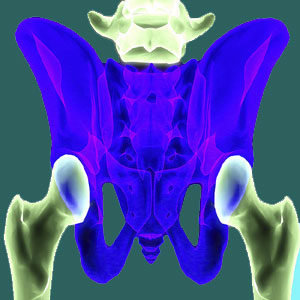
Sacroiliac nerve ablation procedures can be very effective at reducing or even eliminating pain due to various problematic issues within this powerful joint. Nerve ablation can be performed using several methods of care, but the most common is certainly radiofrequency technology.
What is nerve ablation? How is it used to treat sacroiliac joint pain? What are the pros and cons of neurological ablation procedures when used on the SI joint? These are the main questions which will be addressed during the course of this dialog.
This post examines the use of nerve ablation technology to treat SIJ symptomology.
Sacroiliac Nerve Ablation Defined and Explained
Nerve ablation is any form of treatment that (usually) temporarily disables the nerve’s ability to signal. This therapy prevents pain signals from being transmitted from the sacroiliac joint to the brain. Since the signals can not pass, pain never registers.
Nerve signals are electrical in nature and travel neurological pathways like cars on a highway. Ablation procedures set up road blocks on the highway, preventing nerves from passing along pain signals to the brain. In essence, pain still exists, but it is simply not experienced.
Nerve ablation is always considered a form of symptomatic treatment and is therefore sub-par to curative care. However, since curative options are more dramatic and risky, many patients are content to stick with symptom-targeting care like nerve ablation due to good results and fewer negative consequences.
Nerve ablation is widely used in the back pain treatment sector, mostly for spinal issues. There are many positive and negative aspects of treatment to consider, but the therapy remains both popular and widely practiced due to its generally good benefit to risk ratio.
Nerve Ablation Pros and Cons
Nerve ablation is used to treat many different diagnoses in many parts of the body. Almost anytime a nerve can be singled out as the suspected source of painful signals, that nerve can be temporarily disabled using various ablation practices to provide symptomatic relief.
Let’s look at some of the pros of the therapy:
Nerve ablation is invasive, but only minimally so. The procedure is much like an injection, rather than a surgery. There is no large incision and the entire procedure can be easily guided using fluoroscopy (live x-ray) technology for the most accurate results.
The risks of nerve ablation are low. Complications are rare, but the procedure does not work well for every patient. Therapeutic ineffectualness is the most common downside.
When the technique does work, it can provide great pain relief that may last for weeks or months. There is no way to accurately predict the duration of efficacy, but the procedure can easily be repeated as necessary if the pain returns.
For some patient profiles, nerve ablation can help to provide a cure, since it allows the patient to rehabilitate the joint without pain. This can be very important during physical therapy and may lead to a lasting cure for some diagnoses.
The procedure allows patients to reduce or eliminate the need for risky and unhealthy drug therapies for pain management.
Now, let’s take a look at the downsides of nerve ablation for sacroiliac pain:
The primary con is that ablation is symptom-based care. In most cases, no cure will be provided, since the underlying painful issue is not treated at all.
Some patients do not enjoy good pain relief results and other patients only enjoy short-term reduction of pain. It is difficult to predict which patients will respond well and which will not, prior to treatment.
There is some degree of risk, since the procedure is invasive. Possible complications include continued bleeding, permanent nerve injury, joint damage, escalated pain and infection. Most complications are minor and not permanent.
Sacroiliac Nerve Ablation Options
Nerve ablation is typically performed using radiofrequency technology. This is a form of invasive diathermy, using heat to temporarily disable nerve fibers. There are other forms of heat ablation is use, as well.
Cryotherapy uses extreme cold to perform ablation. This technique provides similar results, but is much less common and less popular.
If multiple rounds of ablation are successful, some patients may elect to have nerve permanently disabled using more extreme versions of ablation or even choose to have the offending nerve severed. This is rare, since physicians tend to not recommend permanent damage to nerve tissues. However, for select cases, this might provide a lasting cure for SIJ pain and is still therefore worth considering for indicated patients.





